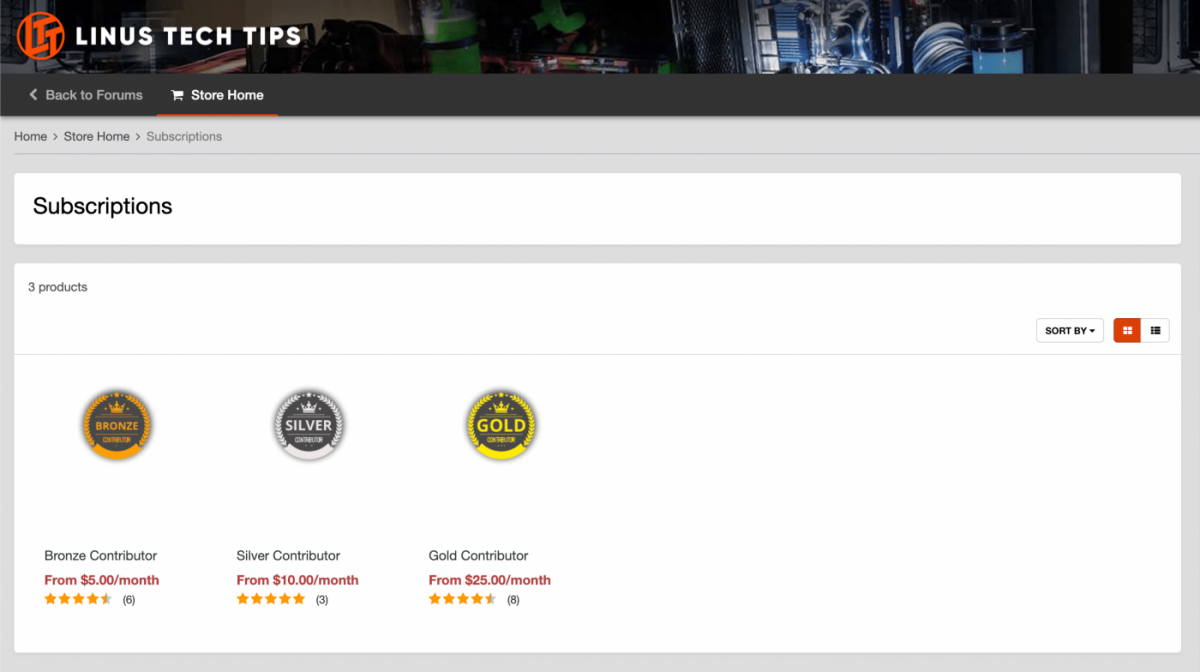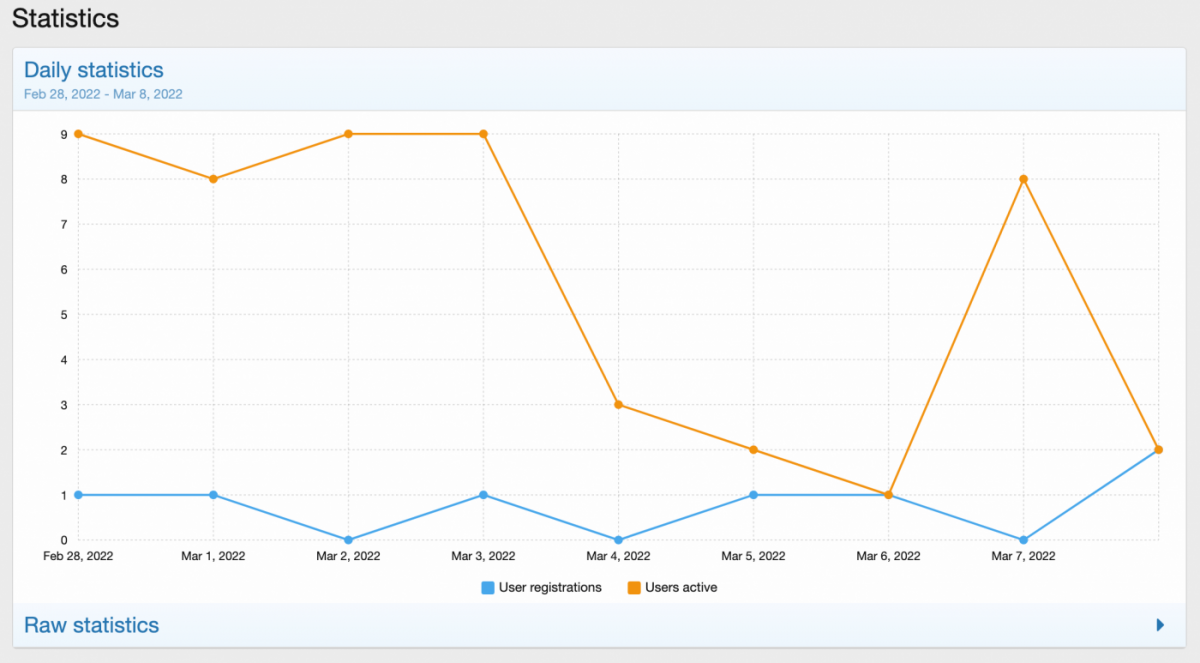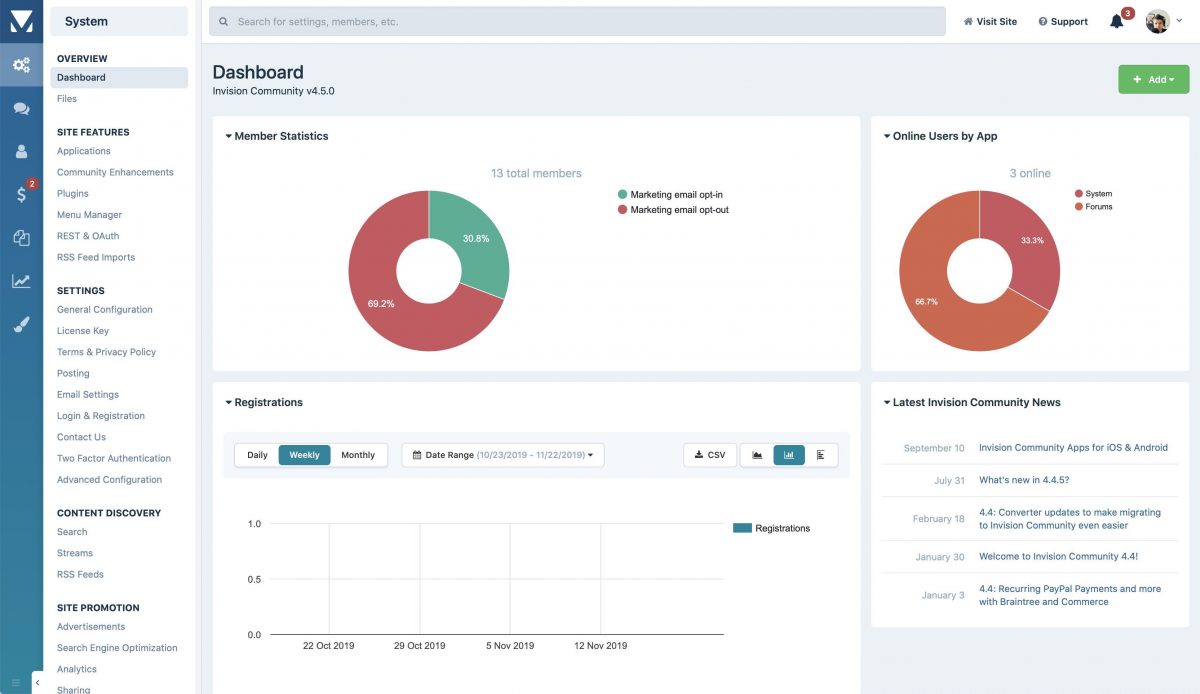Share This Article
Over the course of working with online communities, we’ve looked into options for community software to make the best decisions based on platform reliability, easy functionality extension, platform costs, and update frequency in a reality where keeping up with the modern experience of social media platforms is crucial.
These factors have led us to consider XenForo and Invision Community. These frontrunners have unique pros and cons and we hope after reading this article you can make an informed decision on which platform is best for your community and your users.
A background on these community softwares

XenForo
XenForo is one of the younger competitors in the market, with its first stable release in 2011, but with 18% market share in the top one million sites (Source), this forum software is one of the most popular options.
At roughly $345 USD initial cost and $95 USD for a yearly renewal (Source) for the full suite, its cost is at the low end of paid community software. However, there’s a downside to being more affordable. With an average release cycle of two months for bug fix releases and roughly two years per major update, releases are considerably slower than competitors.

Invision Community
Originally released in 2002, Invision Community is one of the original five forum software solutions that still exists to this day.
Invision Community has roughly 9% market share in the top one million sites (Source), making it fall behind XenForo. The difference in market share is most likely influenced by its considerably higher cost at $850 for the full suite on initial purchase and a $300 yearly renewal (in two installments of $150 per 6 months) (Source), which is at the topmost end of the market.
With a larger development team and the available funding from its pricing model, it is not surprising that updates come a lot more regularly, with bug fix releases averaging between one and two months, and major updates roughly every 12 months.
With the latest large installment of Invision Community being released in 2015, its current code base is considerably older than XenForo, released in 2017.
Software functionality

Managing and sharing community content
Both softwares come with a forum component (this is required in XenForo and optional in Invision Community), which offers all the basic and much of the advanced functionality a modern forum would need. Both also optionally offer file sharing and gallery components as an addition to basic required functionality.
Content management is also supported by both platforms via a custom page system. Invision Community takes a clear lead in this area, providing a page builder with components, file management, and automated data fetching. Compared to XenForo, which technically allows custom data to be added, but only if you write your own PHP code.

Platform monetization for long term stability
Equally ahead are Invision Community’s monetization features. With a fully integrated shop, integrated payment handling for their file sharing component, and other integrated monetization features throughout the platform, it takes a clear lead over XenForo, which natively only supports user upgrades to allow users to purchase additional permissions.

Using statistics for community success
Where XenForo has a basic statistics system that offers you daily counts on KPIs such as posts and user registrations, Invision Community offers a tremendous amount of data you can drill into, broken down by relevant dimensions such as hardware used to access your site (desktop, mobile, etc.), user group, community component (shop, forum, etc.), and more.
Considering code quality
The current minimum PHP requirement for XenForo and Invision Community software is PHP 7.2, with seemingly little intention to raise the requirement in the foreseeable future. This comes at a tremendous cost, because PHP 7.2 support ended over a year ago (Source) and PHP 7.4 is also in its final lifespan with only security fix support. This provides problems for developers as the newest version of PHP, 8.1, is not yet fully supported on either platform.
This takes a significant toll on modernity for both platforms’ code bases and the age of both softwares core code is becoming more apparent with each passing day and release. While XenForo is ahead of its competitor, with its latest rewrite only being 5 years in the past, its refusal to push towards modern concepts and PHP support ages the code base more than necessary. Invision Community’s code, having its last major release more than 7 years ago suffers majorly under the weight of its own age, and while the team steadily refactors old components, a full rewrite is vital to drop outdated concepts and modernize the platform.

Developing custom extensions
Analyzing developer onboarding
XenForo is well known for its friendly customization tools, including simple Admin Control Panel options for developers that allow the set up of many common items such as routes, templates, modifications to existing templates, and more. Looking closer at these features, it becomes apparent that many systems aren’t fully fleshed out and require manual preparation before use. For example, instead of creating a controller automatically when you register a new route, the Control Panel will instead inform you that your route hasn’t been found and you need to create it manually first.
In addition to the tools available through the Control Panel, there is also a suite of supporting CLI commands that developers can use. Unfortunately, the distribution is a mix and match. Some items are available exclusively through the CLI, some exclusively through the Admin Control Panel, and a handful are available to both.
Stretching the boundaries of the XenForo code, there’s also several indirect limitations that are evident as you dig deeper into the code. Core areas required for advanced modification are either hard to or outright impossible to modify, some deliberately, and some indirectly through code planning that didn’t consider extendability or performance.
Invision Community in comparison doesn’t suffer many of these problems. The entire system can be fully extended through the class extension system, setting up routes and other items in the Admin Control Panel automatically creates the corresponding files for you so you can skip the boilerplate work and jump into action. Even a full database schema manager comes integrated, where with a few clicks, you can skip writing the boilerplate installation, upgrade, and uninstallation code for your database.
Looking at platform age
The Invision Community code itself suffers under its age though. Despite extensive developer support, Integrated Development Environment-type hinting is essentially defunct through the way extensibility is handled. Unlike XenForo, it doesn’t ship type hinting files which help cope with a lot of issues, but instead requires browsing core files and referencing the original classes. Overall, this costs a lot of time for new developers that haven’t fully found their way around the system, and even veteran developers will have to reference original files frequently to remember function spelling, available arguments and their order, and the like.
Overall, while the learning curve for Invision Community is considerably higher, and the code much older, the workflow feels smoother when compared to XenForo. Although many boilerplate issues can be overcome through building your own suite of developer tools, the limitations of the XenForo framework press heavily on tasks that try to level the software to modern standards and concepts.

Platform extensibility in the 3rd party marketplace
Both platforms come with full support for 3rd party integrations for translations, styling and code modifications, and extensions. With basic, but outdated documentation for new developers available, both softwares make a minimal effort to onboard new developers into their marketplace.
Despite the difficulties new developers may experience, both software suites harbor a 3rd party development marketplace with a moderately active community, sporting approximately 50 translations, 200 to 300 themes, and roughly 1,300 to 1,500 functional modifications and extensions, both paid and unpaid.
Unlike XenForo’s reactive review policy, where 3rd party resources are only reviewed after multiple reported issues, Invision Community’s integrated marketplace is actively reviewed and monitored, boosting the overall trust and reliability of the platform and extension quality.
The takeaways
While XenForo appears more appealing due to its higher market share and lower pricing, Invision Community easily takes the lead when it comes to functional coverage, options for monetization, and superior ability to track critical KPIs through statistics.
If cost is a concern, the price of Invision Community components is flexible and dependent on the requirements of your platform. Also, with security fixes being posted and publicly available for everyone, being on top of having an active license isn’t strictly required for the XenForo or Invision Community platform, further lowering the running cost of your community.
As of 2022, both software platforms are a decent choice, but since XenForo has shifted its focus to introducing a cloud hosted market and has not provided a major software release since mid 2020, Invision Community should be given serious consideration due to its stricter update policy, rich feature set, and code structure that allows for more viable 3rd party modifications.
Our opinion from a developer perspective
As someone who has seen a lot of communities rise and fall and worked a lot with XenForo over the last few years, exploring all its corners and limitations, I’m happy to say that XenForo is still a solid choice for lower budget communities that don’t have the capacity to invest into Invision Community straight away. However, this comes at the long-term price of not being able to capitalize on many of the fantastic features that the latter provides, costing your community and your revenue stream alike.
While XenForo, as a considerably newer software platform definitely has the more convenient code structure to work with and a better onboarding experience for new coders, once you figured out how to work Invision Community, it lacks little of what you would expect from a modern code framework, and even is ahead of XenForo in many aspects, such as flexibility of extensions, developer support in the admin control panel, and more.
Given their vastly different team sizes and pricing models, the Invision Community’s team is a much better resource for developers and community managers alike as well.
Overall, if you intend to start a community today, XenForo is your go-to choice if you are on a budget. If you’re migrating an existing community with a solid enough revenue stream, or if you’re corporate and treat your forum as addition to your services, head straight for Invision Community. And if you’re a developer, why not expand into both marketplaces and see what pays off best for you?


